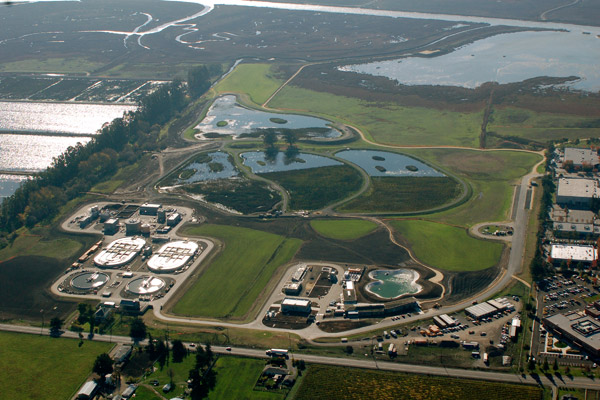
Ellis Creek Water Recycling Facility, Petaluma, California, December 2008
Photo courtesy City of Petaluma, CA
"I am currently working with Carollo Engineers on a new $140 million dollar water recycling facility for the city of Petaluma, California. The project includes oxidation ponds, sewage treatment wetlands, and polishing ponds for the removal of heavy metals, as well as a new 272-acre tidal marsh and mudflat, PETALUMA WETLANDS PARK. As a designer I have always been interested in enmeshing human needs within the larger patterns and purposes of nature. In Petaluma, art and infrastructure, ecological nature and the public landscape, are unified within the image of one of the area's smallest inhabitants-- the "Salt Marsh Harvest Mouse". More than three miles of public trails and interpretive sites trace the patterns of the creature, while revealing the intricacies of wastewater treatment, the tidal cycle, ever-changing patterns of land and water, and the complex relationships between microhabitats and ecosystems.
At the heart of the Wetlands Park, four elevated bermed ponds totaling 30 acres form the mouse's image. Habitat islands in each sewage treatment cell offer protected nesting and refuge for birds, while also directing the flow of water in the basins... Vegetation and substrate varies on islands within each of the polishing ponds, as do shoreline conditions, in order to attract a wide range of different species...
One of the most important aspects of this site is the diversity of ecosystems that occurs within a relatively small area-- tidal sloughs, brackish marsh, mudflats, riparian corridor, and uplands-- combined with positive human interventions: agricultural fields, freshwater ponds, and storm water purification... PETALUMA WETLANDS PARK unifies massive man-made landscapes organized for food production, sewage processing, and water purification, with many layers of public and ecological benefit-- from wildlife habitat restorations and school educational programs, to recreation, tourism, and art. Perhaps most important, it serves as a model for converting sewage to drinkable water. One of my missions as a designer is to create inclusive, life-supporting landscapes that broaden human understanding. Artists have always changed the way we see. Now we need to change the way we act. The new wholeness and harmony lies not in design perfection but in our ability to bring competing populations, interests, and points of view together harmoniously in the real world. Ultimately my projects seek design solutions that are as creative, functional, and biologically productive as nature itself."
Copyright © 2004, Patricia Johanson: "Design Narrative: Ellis Creek Water Recycling Facility and Petaluma Wetlands Park". Reprinted in: Caffyn Kelley, ART AND SURVIVAL, PATRICIA JOHANSON’S ENVIRONMENTAL PROJECTS, Islands Institute, Salt Spring Island, B.C., 2006